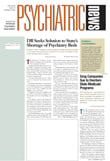Jackie, a 7-year-old boy, shared an unusual hobby with his buddy. They would capture a grasshopper, then pull its legs off one by one.
So what kind of adult has Jackie turned out to be? One with an antisocial personality? Very possibly, but not necessarily, a new study suggests.
The study was conducted by Roman Gleyzer, M.D., a forensic psychiatrist with Western State Hospital in Tacoma, Wash.; Alan Felthous, M.D., a professor of forensic psychiatry at Southern Illinois University School of Medicine; and Charles Holzer III, Ph.D., a professor of psychiatry at the University of Texas Medical Branch in Galveston. It is reported in the April-June Journal of the American Academy of Psychiatry and the Law.
True, animal cruelty is currently used as evidence for the presence of conduct disorder, and evidence of conduct disorder is in turn a prerequisite for diagnosis of antisocial personality disorder in adults. But does animal cruelty really foreshadow an antisocial personality later in life?
A major study to answer the question was published in 1985. It showed that men in the federal prison system with a high rate of recurrent, serious aggression had engaged in more episodes of animal cruelty in childhood than had nonviolent criminals within the federal prison system. However, this particular study did not attempt to determine whether animal cruelty in childhood is linked with adult antisocial personality disorder per se. So Gleyzer and his coworkers decided to undertake an investigation to answer the question.
They identified 48 men with a history of animal cruelty by reviewing records of all criminal defendants in Galveston County, Tex., from 1984 through 1996. These men served as their index subjects. They also identified 48 men from the same pool of criminal defendants who did not have a history of cruelty to animals and who matched the index subjects on age, sex, ethnic background, and date of psychiatric evaluation. These men served as controls. They then analyzed the psychiatric diagnoses that the index subjects and controls had received and compared diagnoses between the two groups.
Indeed, as Gleyzer and his coworkers anticipated, there were more cases of antisocial personality disorder in the animal cruelty group than in the control group, and the difference was statistically significant. The researchers thus concluded that this finding supported their hypothesis that cruelty to animals in childhood is linked to adult antisocial personality disorder.
However, only a little over one-third of the animal cruelty group had antisocial personality disorder. So the researchers cautioned in their report that animal cruelty “should not be considered to be diagnostic of antisocial personality disorder any more than any other single behavioral criterion is diagnostic of this disorder.”
Further, their findings suggest that animal cruelty in childhood might presage personality disorders in adulthood other than the antisocial variety. Specifically, they found that over one-third of the animal cruelty subjects had personality disorders other than the antisocial type—borderline, schizotypal, paranoid, and mixed with and without antisocial features, for example—whereas only 19 percent of controls did. The difference was not statistically significant, however.
But when they grouped antisocial personality disorder with the other personality disorders, they found that 75 percent of the animal cruelty group had one of these personality disorder types, whereas only 27 percent of the control group did, and the difference was statistically significant.
“This raises the troubling possibility that animal cruelty may be related more to character disorders in general and not very specifically to antisocial personality disorder,” Gleyzer and his colleagues suggested. “However, we believe this finding is probably due to the predominance of antisocial personality disorder among the various personality disorders represented in this group.”
In any event, whether animal cruelty in childhood foreshadows antisocial personality or other types of adult personality disorders, it does not seem to predict adult psychosis. Gleyzer and his coworkers found no statistically significant difference between the number of index subjects with psychotic disorders (15 percent) and the number of controls with them (21 percent). ▪
